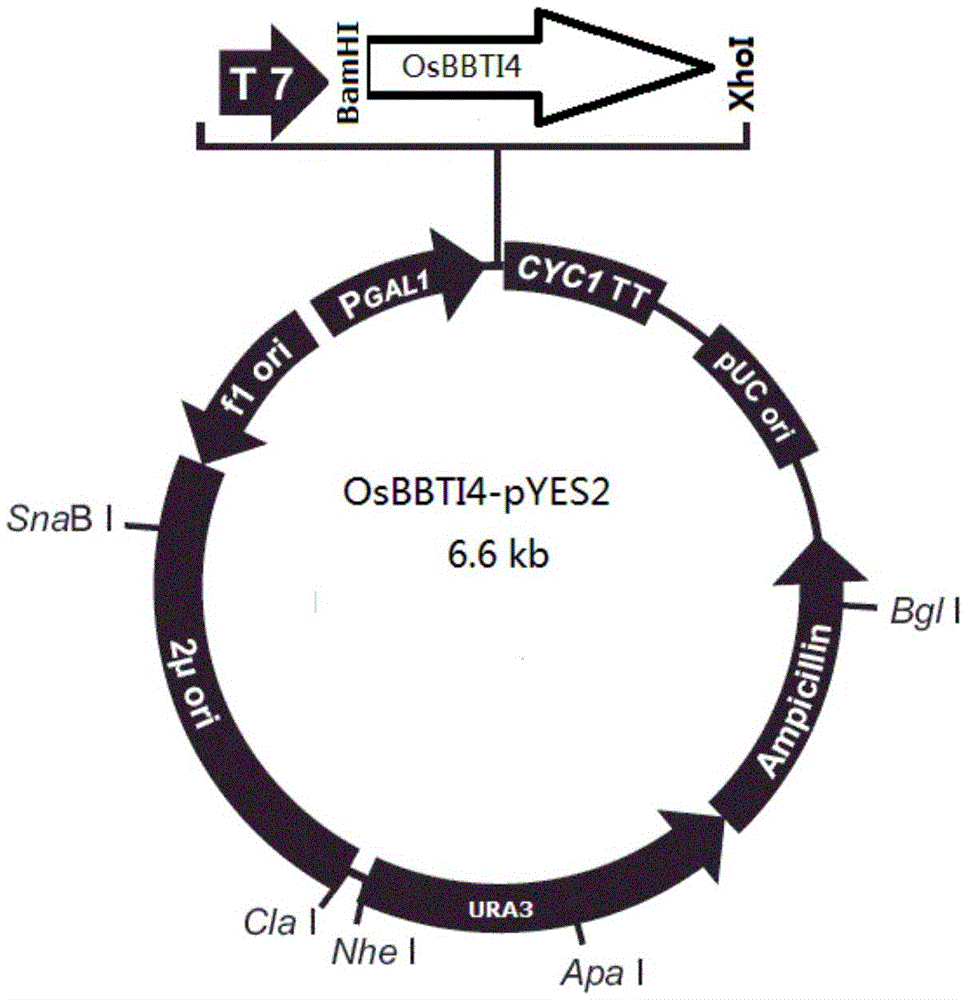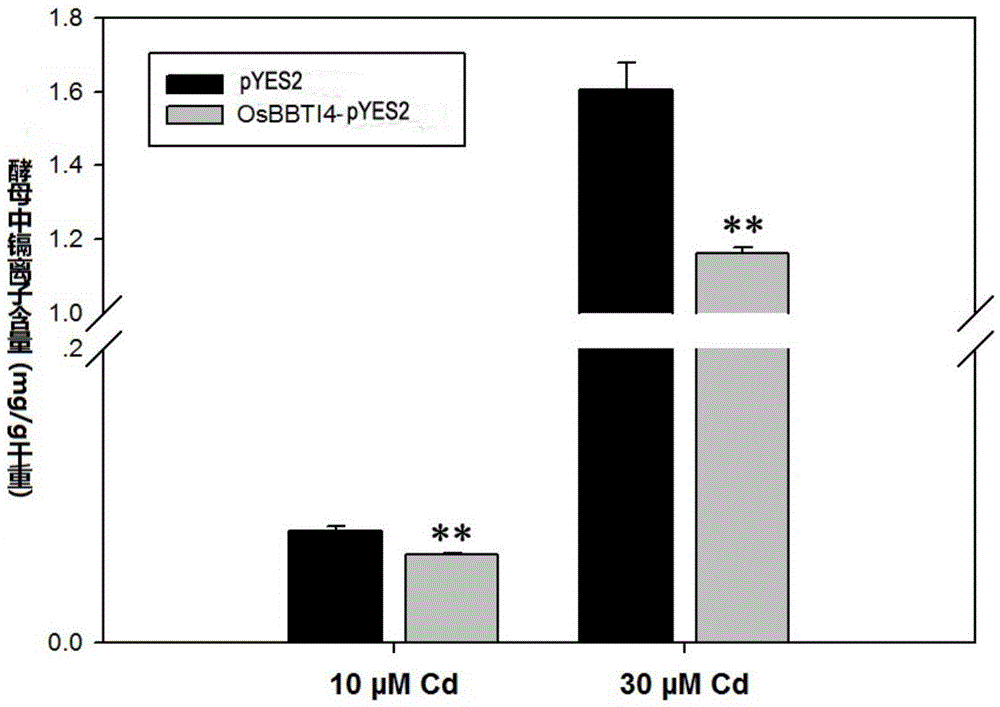New application of OsBBTI4 (oryza sativa Bowman-Birk trypsin inhibitor 4) gene
A rice and genetic technology, applied in the direction of protease inhibitors, application, genetic engineering, etc., can solve the problems of inferring the role of OsBBTI4 gene, etc., and achieve the effect of reducing cadmium accumulation and promoting efflux
- Summary
- Abstract
- Description
- Claims
- Application Information
AI Technical Summary
Problems solved by technology
Method used
Image
Examples
Embodiment 1
[0064] Example 1: Expression of the OsBBTI4 gene in Saccharomyces cerevisiae reduces the accumulation of cadmium in yeast
[0065] According to conventional methods, the recombinant expression vector OsBBTI4-pYES2 of Saccharomyces cerevisiae was constructed, such as figure 1 shown.
[0066] Cultivate Saccharomyces cerevisiae strain Δycf1 (purchased from Euroscarf, European Yeast Research Center, http: / / web.uni-frankfurt.de / fb15 / mikro / euroscarf / , strain number Y04069), use pYES2 plasmid and recombinant OsBBTI4-pYES2 to the above yeast to convert. Since the OsBBTI gene is placed under the regulation of the yeast galactose-induced promoter PGAL1 (see figure 1 shown), OsBBTI4-pYES2 was transformed into Saccharomyces cerevisiae and grown on the selective growth synthetic medium (Selective Growth Synthetic Medium, SDmedium) supplemented with galactose, which could induce the heterologous overexpression of OsBBTI4 in yeast.
[0067] The method used for yeast transformation is the ...
Embodiment 2
[0080] Example 2: Construction of OsBBTI4 Gene Transgenic Overexpression Vector and RNAi Vector and Rice Genetic Transformation
[0081] Take 100ng of rice genomic DNA as a template, use primers OsBBTI4OEF: 5'-CGGGATCCATGAGCAACACCACCATGGC-3' and OsBBTI4OER: 5'-CGGGATCCCTAGTTCTCCGCTCGGGGTT-3' (SEQ ID NO.3 and SEQ ID NO.4) to amplify and construct OsBBTI4 gene transgene overexpression vector Fragment; primers OsBBTI4RIF: 5'-GGGGTACCACTAGTATGAGCAACACCACCATGGC-3' and OsBBTI4RIR: 5'-CGGGATCCGAGCTCCTAGTTCTCCGCTCGGGGTT-3' (SEQ ID NO.5 and SEQ ID NO.6) were used to amplify the fragment for constructing the OsBBTI4 gene transgenic RNAi vector. The rice transgene overexpression vector used in the present invention is pCU1301 [ChenR, ZhaoX, ShaoZ, WeiZ, WangY, ZhuL, ZhaoJ, SunM, HeR, HeG (2007) RiceUDP-glucosepyrophosphorylase1isessentialforpollencallosedepositionanditscosuppressionresultsinanewtypeofthermosensitivegenicmalesterility. On this basis, the rice transgenic overexpression vec...
Embodiment 3
[0094] Embodiment 3: Determination of heavy metal cadmium content in transgenic rice seeds by atomic absorption spectrometry
[0095] Seeds of the above-mentioned homozygous strains were sown into 9 cm diameter petri dishes to germinate at 37°C, and after 7 days, the seedlings were transferred to nutrient solution (control) and nutrient solution supplemented with 0.01 mM Cd for cultivation and growth. The composition of the nutrient solution is: mother solution 1: 91.4gNH 4 NO 3 , 32.4gMgSO 4 ·7H 2 O, add water to make up to 1L; mother liquor 2: 88.6gCaCl 2 , add water to 1L; mother liquor 3: 40.3gNaH 2 PO 4 , 71.4gK 2 SO 4 , add water to 1L; mother liquor 4: 0.943gH 3 BO 4 , 1.5gMnCl 2 4H 2 O, 0.074g (NH 4 ) 6 Mo 7 o 24 4H 2 O, 0.031gCuSO 4 ·5H 2 O, 0.035gZnSO 4 ·7H 2 O, add water to make up to 1L; mother liquor 5: 6.9gFeSO 4 ·7H 2 O, 9.3gNa 2 EDTA·2H 2 O, add water to make up to 0.5L. When in use, add 5mL of No. 1-5 mother liquor for every 4L of nutr...
PUM
 Login to View More
Login to View More Abstract
Description
Claims
Application Information
 Login to View More
Login to View More - R&D
- Intellectual Property
- Life Sciences
- Materials
- Tech Scout
- Unparalleled Data Quality
- Higher Quality Content
- 60% Fewer Hallucinations
Browse by: Latest US Patents, China's latest patents, Technical Efficacy Thesaurus, Application Domain, Technology Topic, Popular Technical Reports.
© 2025 PatSnap. All rights reserved.Legal|Privacy policy|Modern Slavery Act Transparency Statement|Sitemap|About US| Contact US: help@patsnap.com



